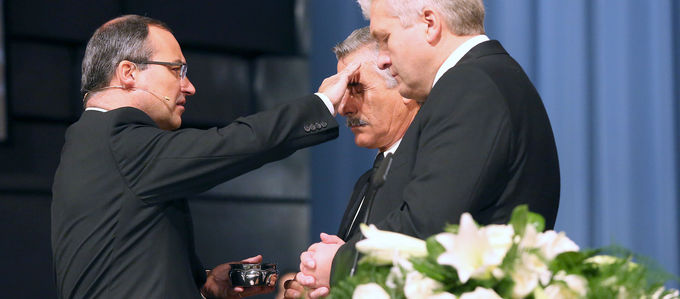
Things got off to a turbulent start. But step by step the New Apostolic Church has put order into its sacraments for the departed. Once the practical part had been brought into line, the theory followed suit. Here is the history in fast-forward mode.
In the beginning, there was a lot of euphoria about the sacraments for the departed. The prophecies of the congregation determined whether and when the Apostle would administer baptism with water or the Spirit. Visions defined who was to be baptised in place of the deceased. It could therefore happen that Luther, Calvin, and others were thought to have been sealed.
Mothers of faith and vessels
The decade around 1910 saw a shift in the enthusiasm towards calmer waters. Gradually, the custom of naming the deceased recipients of sacraments individually was abolished. Chief Apostle Niehaus regularly conducted divine services for the departed on the day after Christmas and, in the 1920s sometimes also on Pentecost Monday.
The Apostles’ College settled the question of who should receive the sacraments in place of the departed: two so-called ministerial vessels, that is, two ministers, were to serve as “baskets”—typically a woman for women, a man for the men, mostly the eldest Deacons and Deaconesses, a ministry that still existed at the time. For baptisms, this role was assigned to two women, the so-called mothers of faith. In the case of prematurely deceased children, parents were also allowed to step in. Since the 1930s, this function as vessel has been reserved for ministers.
Two at the altar three times a year
The “Lord’s Supper for the dead”, which according to Dutch sources, had been celebrated since 1886, provided the model for this double representation. Chief Apostle Krebs had ruled on the matter in 1898. Thus there were two vessels, on the one hand the proxy, who received the bread, on the other hand the so-called ministerial cup, who received the wine. The New Apostolic wafer consisting of bread and wine had yet to be invented.
Since then, the Lord’s Supper for the dead was to be celebrated three times a year. This too served as a model—still a good half a century later. In 1954 Chief Apostle Bischoff decreed that the other sacraments for the dead should be celebrated with the same frequency; this rhythm still applies today. And just like, Father Krebs, he justified this number with the covenant obligations in Exodus 34: 23.
Clarifying of how access is provided
After 1898, 1910, and 1954, the year 2001 marked the fourth milestone in the history of the New Apostolic concept of the departed: “There is no compelling necessity to unlock the access to the altar and the kingdom of God by means of a special prayer by the Chief Apostle prior to a divine service for the departed,” a doctrinal essay stated at the time.
Chief Apostle Krebs had already talked about unlocking the realms of the beyond. Chief Apostle Bischoff ritually proclaimed this in the opening prayer of the divine service for the departed. In view of the many time zones across the globe, Chief Apostle Schmidt moved the act to the evening before. Chief Apostle Urwyler came to the insight that the deceased are not bound by space and time. And under Chief Apostle Fehr, a special edition of the then Word of Life, 03/2001, made clear: “The realms of the beyond are open through the once-brought and eternally valid sacrifice of Jesus Christ.”
Between theory and practice
What still needs to be mentioned is the year 2005, when the brochure Belief in the Afterlife for New Apostolic Christians was published. It was the first publication in 70 years that made doctrinal statements on this subject: this after Lichtblicke ins Totenreich (Insights into the realm of the dead, 1905), and Das Leben nach dem Tode (Life after death, 1935).
While these forerunners of our concept of the departed were mostly based on accounts of experiences by members, the brochure published in 2005 attempted to draw its conclusions on a biblical basis. However, the aim of this booklet was not to establish a doctrine, but only summarise the doctrine and practice of the time.
The brochure was thus an important step on the way to the great book of faith. The Catechism of the New Apostolic Church, published in 2012, thus completed the attempt of presenting the world of the departed in a theologically responsible manner. The next part in this series will deal with our current practice.
Photo: freshidea – stock.adobe.com













